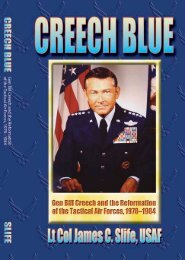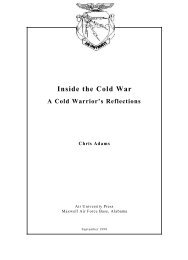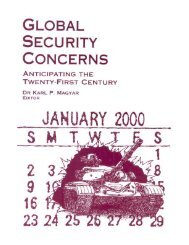There is one major difference between a manned aircraft and an unmannedaircraft that studies rarely address: Humans can <strong>for</strong>m strongemotional bonds to manned aircraft (at least in Western societies). For pilotsand aircrews, this is especially true. 68 UAVs do not conjure up comparablelevels or intensities of similar sentiments. For a UAV there is nosteadfast requirement <strong>for</strong> recovery; the absence of humans on board eliminatesthe major driving factor to have a vehicle safely return and land.Political and military leaders should thoroughly explore various characteristicsof airpower, both positive and negative, to determine what meansare best suited <strong>for</strong> what roles. A part of this process is to determinewhether missions exist that are worth the intentional loss of flying machines.At the same time, decision makers must consider how to overcomelimitations associated with human emotional attachment to aircraft.In summary, unmanned aircraft do not elicit human emotions associatedwith life or spirit, and they do not attract the attention given tomanned aircraft. Manned aircraft are designed not only to per<strong>for</strong>m aerialfunctions but also to sustain and protect humans on board. They musthave protective qualities to safeguard the pilot. This means manned aircrafthave inherent defensive characteristics. RPVs, with operators physicallyresiding elsewhere, can be more offense oriented. As such, they offerpotential advantages over manned aircraft in serving as a strategic <strong>for</strong>ceand as an offensive weapon. These advantages can be further exploited bydesigning RPVs to be “more economically replaced than rescued, salvaged,or protected.” 69Notes1. Noel Falconer, “Expend! Expend! Expend!” in RPVs Conference, Bristol 1984 (spinetitle), RPVs: <strong>Remotely</strong> <strong>Piloted</strong> <strong>Vehicles</strong> (cover title) (Bristol, U.K.: Royal Aeronautical Society,1984), 4.1.2. Steven M. Shaker and Alan R. Wise, War without Men: Robots on the Future Battlefield(Washington, D.C.: Pergamon-Brassey’s, 1988), 30. In contrast to Japanese suicideaircraft, there was a manned version of the V-1 Buzz Bomb (named the Reichenberg) developedby the Germans towards the end of World War II. While some Allied observersthought it was intended <strong>for</strong> kamikaze attacks, instead it “was an experimental test aircraftdesigned to iron out some control problems, rather than becoming a suicide bomber.”3. In<strong>for</strong>mation and data contained in this paragraph were obtained from display andvideo presentations found at the USAF Museum located at Wright–Patterson AFB, Ohio.The O h k a (Cherry Blossom) was carried beneath a “mother” aircraft, such as a twin-engineMitsubishi “Betty” bomber. When the pilot reached a favorable position <strong>for</strong> his attack, hefired the rockets and dove at high speed into his intended victim.4. “Predator, DarkStar and Other Cult Classics,” The Economist, 17 June 1995, 81.5. Peter R. Murray, “B-17 Flying Fortress—Unmanned Version,” IEEE Transactions onAerospace and Electronic Systems, vol. AES-15, no. 5, September 1979, as referenced inJay Womack and Arthur Steczkowski, “Review of Past and Current Trials and Uses of Unmanned<strong>Vehicles</strong>,” Report no. HSD-TR-87-011/United States (Dayton, Ohio: Air Force SystemsCommand, 1988), 2–7.6. Ibid., 30.59
7. “Report: Military Crashes Down,” on-line, Internet, Air Force News, 6 February 1996.The General Accounting Office (GAO) found that the cost is still high despite the numberof military air crashes declining from 309 in 1975 to 76 in 1995. Number of deaths fromair crashes dropped from 285 in 1975 to 85 in 1995.8. On 1 February 1996, an F-14A crashed in a Nashville, Tenn., residential neighborhoodkilling both crewmen and three civilians on the ground. On 18 February, an F-14Dplunged into the Pacific off southern Cali<strong>for</strong>nia, killing both crewmen. Four days later, anF-14A crashed in the Persian Gulf, but <strong>for</strong>tunately both crewmen ejected safely and wererescued. In August 1995 two Tier 2 Predator UAVs were lost over Bosnia within four days.9. “DOD’s Use of <strong>Remotely</strong> <strong>Piloted</strong> Vehicle Technology Offers Opportunities <strong>for</strong> SavingLives and Dollars,” GAO survey (Washington, D.C.: GAO, 1981), 19. A questionnaire wassent to 85 people experienced in the RPV technology field, and 77 responded. Those thatconducted the survey acknowledged it “may not be an unbiased <strong>for</strong>um of views on RPVs,but constituted the most knowledgeable source of in<strong>for</strong>mation that the GAO could identify.”The original chart displayed the results on a scale from 1.00 (major disadvantage) to3.00 (major advantage). In order to allow <strong>for</strong> a greater margin of error (in bias and opinion),this author took the results and displayed them according to three ranges: 1.00 to1.66 represented “major disadvantage,” 1.67 to 2.33 represented “counterbalancing advantage/disadvantage,”and 2.34 to 3.00 represented “major advantage.”10. Ibid. Pilot risk was given a numerical score of 3.00, and recovery was 1.32.11. GAO survey, 19. For the representative RPV in table 6, all those surveyed unanimouslygave it a perfect 3.00 (major advantage) rank score.12. Lee B. Kennett, The First Air War: 1914–1918 (New York: Free Press, 1991), 221.This was a statement made in 1939 by the Air Staff to British Army leaders. It referencedthe 30 percent losses per day suffered during “trench flights” in November 1917.13. “Airpower and the 1972 Spring Invasion,” USAF Southeast Asia monograph series,vol. 2, monograph 3, ed. A. J. C. Lavalle (Washington, D.C.: Department of the Air Force,1985), 35–43.14. Lt Col Steve Turner, quoted in William L. Smallwood, Strike Eagle: Flying the F-15Ein the Gulf War (McLean, Va.: Brassey’s, 1994), 117.15. S. L. A. Marshall, Men Against Fire: The Problem of Battle Command in Future War(1947; reprint, Gloucester, Mass.: Peter Smith, 1978), 204, as referenced by Conrad C.Crane, Bombs, Cities, and Civilians: American Airpower Strategy in World War II (Lawrence,Kans.: University Press of Kansas, 1993), 48.16. Womack and Steczkowski, 2–15.17. F-117 cost from Richard P. Hallion, Storm Over Iraq: Air Power and the Gulf War(Washington, D.C.: Smithsonian Institution Press, 1992), 294; B-2 cost from John A. Tirpak,“With the First B-2 Squadron,” Air Force Magazine, April 1996), 38.18. TLAM cost from Hallion, 250; Predator cost from Air Force Link, on-line, Internet,available at http://www.dtic.dla.mil/air<strong>for</strong>celink/photos/c0196_predat7.html.19. Col William E. Krebs, “Did We Err in the Development of <strong>Remotely</strong> <strong>Piloted</strong> <strong>Vehicles</strong>(RPVs)?” Research Report no. MS 018-79 (Maxwell AFB, Ala.: Air War College, 1979), 10.20. Ibid., 55.21. James Canan, “Steady Course <strong>for</strong> Unmanned Aircraft,” Air Force Magazine, March1991, 87.22. GAO study, 3.23. Maj Ronald L. McGonigle, “Unmanned Aerial <strong>Vehicles</strong> (UAVs) on the Future TacticalBattlefield—Are UAVs an Essential Joint Force Multiplier?” (Fort Leavenworth, Kans.:8 December 1992), 33. Various sources assert that RPVs eliminate the need <strong>for</strong> life supportand redundant systems.24. Tirpak, 41.25. Krebs, 10; and GAO survey, 3.26. Ibid., 26.60
- Page 1 and 2:
Expendable Remotely PilotedVehicles
- Page 3 and 4:
ContentsChapterDISCLAIMER . . . . .
- Page 5 and 6:
AbstractThe future holds an acceler
- Page 7 and 8:
AcknowledgmentsI thank all the stud
- Page 9 and 10:
aircraft. Incorporating the added d
- Page 11 and 12:
UAVs were more easily defined when
- Page 13 and 14: Chapter 4 answers the question: Why
- Page 15 and 16: Chapter 2History and BackgroundWe h
- Page 17 and 18: The Wright brothers are deservedly
- Page 19 and 20: aerial bombs), the British took the
- Page 21 and 22: UAVs during World War II to a few g
- Page 23 and 24: On 27 October of that year, another
- Page 25 and 26: United States to look beyond reconn
- Page 27 and 28: ary 1996, Gen Ronald R. Fogleman, A
- Page 29 and 30: 29. Shaker and Wise, 28.30. Michael
- Page 31 and 32: Chapter 3Strategic Offensive Airpow
- Page 33 and 34: ombs, as well as a high sortie rate
- Page 35 and 36: It thus follows that future air cam
- Page 37 and 38: possible for small formations to ac
- Page 39 and 40: spite the successes, it is easily p
- Page 41 and 42: The transmissions used by a control
- Page 43 and 44: 33. Air Force Scientific Advisory B
- Page 45 and 46: diverted 75 percent of its B-29s aw
- Page 47 and 48: Table 6Remotely Piloted Vehicle Adv
- Page 49 and 50: million dollars each. The unit flya
- Page 51 and 52: Relative Ranks for Fewer Design Con
- Page 53 and 54: mission) the open bomb bay doors si
- Page 55 and 56: Relative Ranks for Flight Noise Are
- Page 57 and 58: Owens also stated that the military
- Page 59 and 60: All forms of manned and unmanned ai
- Page 61 and 62: Relative Ranks for Reliability Area
- Page 63: KEY: ● Major Advantage Counterba
- Page 67 and 68: 62. McGonigle, 34.63. Ibid., 33.64.
- Page 69 and 70: expendable RPVs, American political
- Page 71 and 72: cybornaut activates engine thruster
- Page 73 and 74: Chapter 6ConclusionConstant evaluat
- Page 75: one role. A countless combination o






